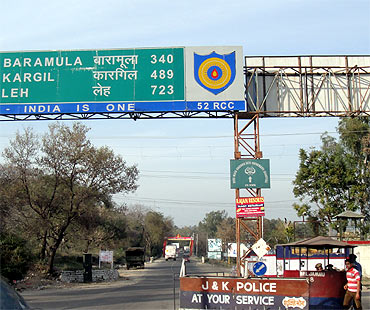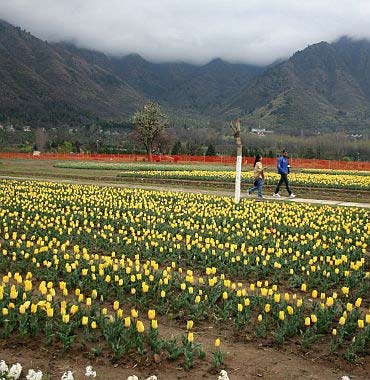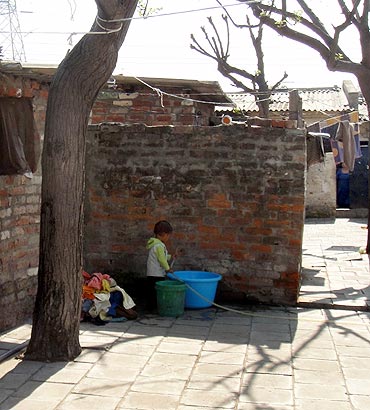Photographs: Archana Masih/Rediff.com Archana Masih
The Kashmiri Pandits in this narrative have lost hope of returning to that place in the Kashmir valley they once called home and that is one of contemporary India's biggest tragedies.
They may have got new homes in a township after 20 years, but they know they are not home yet. Archana Masih reports on a people callously termed as 'migrants' in their own land. Part IV of a special series.
Part I: A House for Mr and Mrs Raina
Part II: 'Is there no place for Pandits in this nation?'
Part III: 'Wasn't what Pandits experienced a genocide?'
When Prime Minister Manmohan Singh, who had to leave his ancestral home in East Punjab, now in Pakistan, after India was partitioned in 1947 visited Kashmiri Pandit migrant camps in Jammu in 2004, he ordered a ministerial team to address the needs of the camp-dwellers.
 |
The Jagti township, with 4,218 apartments to house 25,000 people, was a result of that initiative. However, the new apartments are not a permanent rehabilitation for the Pandits, but a temporary shelter. That is the reason why Babli Bhat, the widow in the Muthi camp, still remains uncertain about herself and the future of her school-going daughter.
Dr Singh, at the inauguration of the township, had expressed hope that the situation would turn normal in the valley and the migrants would return to their homes. But that is a distant dream for most Pandits. While 4,624 applications have been received from families who wish to return under the prime minister's relief and rehabilitation package, no family has returned so far.
The package details for those who return to the valley are displayed prominently in the relief commissioner's office compound: Rs 750,000 (approximately $15,500) for a damaged house, Rs 200,000 (approximately $4,400) for dilapidated/unused house, employment to 6,000 unemployed youth, financial assistance to start self-employed ventures, Rs 100,000 (approximately $2,200) to those with agricultural holdings etc,
Yet, it will take much more than material incentive to bring the Pandits back to Kashmir.
...
'Kashmiri Pandits and Kashmiri Muslims have lived together for thousands of years'
Image: Tulips in bloom in Kashmir.Photographs: Umar Ganie
'The future of the Kashmiri Pandit is uncertain, though of late there are signs of favourable change in Kashmir," says Mohammad Sayeed Malik, a longtime political observer and resident of Srinagar.
"The huge hurdle is security and there is a question mark on the possibility of their return, but Kashmir misses its Pandits. We have lived together for thousands of years; have common shrines; our social, cultural life is incomplete without them."
 |
Malik says the Pandits have not only suffered a material but a psychological loss; but feels that in recent years Kashmiri plurality is reasserting itself.
"As militancy has subsided, the mindset is changing in Kashmir. Relatively the atmosphere is not hostile or as inimical as it was in the past and some Pandit families are returning quietly," he says.
The state government claims that 2,000 Pandit youth have already joined posts in the valley after 6,000 jobs were announced. Malik says several of these youth have preferred staying in accommodation provided by locals over government facilities.
"That means the atmosphere is changing, if it hasn't changed completely," he adds.
...
They are not home yet
Image: The Muthi camp in Jammu.Photographs: Archana Masih/Rediff.com
It was Singh's seventh visit to Kashmir as prime minister when he inaugurated the new township for Kashmiri migrants last month. He also released a magazine, Rebuilding Life, which says that the Jagti township is surrounded by lush green forests thus giving it an ambience of the 'salubrious environs of the Kashmir valley, with a direct view of the abode of Vaishnodevi, appealing to the aesthetic and religious values of the migrant population.'
It further says the two-room apartments have been constructed for making the stay of the migrants comfortable, but for permanent rehabilitation migrants will have to return to their homes in the Kashmir valley.
 |
Callously termed as 'migrants', the Pandits have experienced unspeakable loss in the last 20 years as Kashmir continues to remains India's most volatile state. The veneer of normalcy hangs perilously over Kashmir and can crack with changing moods, changing seasons. Last summer 117 people died over five months in a standoff between security forces and disgruntled youth who took to Srinagar's streets.
The Pandits in this narrative have lost hope of returning to that place in the Kashmir valley they once called home and that is one of contemporary India's biggest tragedies.
They may have got new homes in a township after 20 years, where they will soon fix their name plates to new doors. But they know they are not home yet.
...
The Nowhere People
Image: A camp for Pandits in Jammu. The camps will be emptied and residents moved to a new township.Photographs: Archana Masih/Rediff.com
Kashmiri Pandits have been in exile since the early 1990s after Islamic fundamentalists in the Kashmir valley launched a campaign of terror and intimidation against the community. Armed militants, reportedly supported by Pakistan's Inter Services Intelligence directorate, took to terrorism aimed at subverting the Indian State and drove the Hindu community out of their centuries-old habitat.
The Pandits had lived in the Kashmir valley for over 5,000 years. Some of Hinduism's most revered sites -- the Amarnath shrine, Kheer Bhawani, the Vaishnodevi shrine, Hari Parbat, the Shankaracharya temple -- are located in Jammu and Kashmir.
 |
The exodus of Pandits from the Kashmir valley began in the early 1990s as fear of being killed gripped the small ethnic minority. Inflammatory speeches and threatening posters targeted Pandit families as the atrocities against them increased, forcing them to flee.
The community had hoped to return after the situation improved, but have not been able to do so for 20 years because normalcy has yet to return to the valley and they fear a risk to their lives.
The exiled Pandits are mostly spread across camps in Jammu city, Udhampur and Delhi. The Jammu and Kashmir government says approximately 200,000 Pandits live in Jammu and are called 'Kashmiri migrants.' Kashmiri Pandit organisations say the community numbers around 700,000 worldwide.
The Panun Kashmir (Our Own Kashmir) movement, an organisation of displaced Pandits, advocates the creation of a separate homeland carved out of Kashmir for the exiled community.
Concluded





article